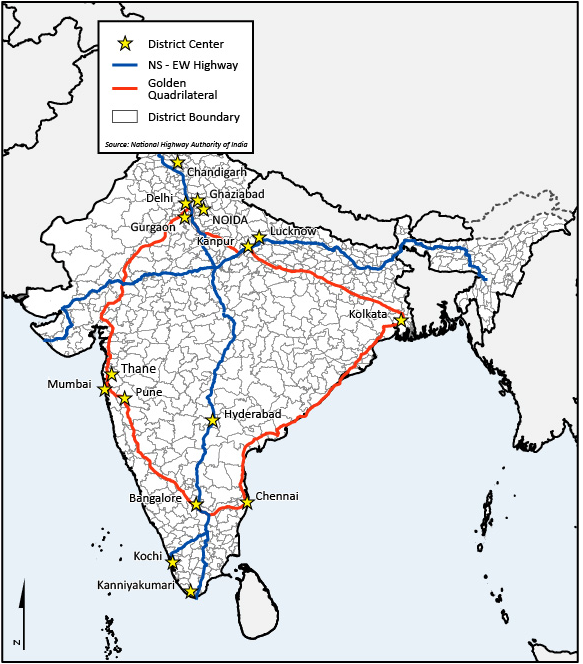The Golden Quadrilateral, which connects four major cities in India, is the fifth-longest highway in the world. This column presents research that finds that by improving connectivity, the highway has helped with the efficient distribution of industries across locations. It has facilitated the shift of land and building intensive industries from the core to peripheries of cities, and has made medium-sized cities more attractive locations for manufacturing activity.
Transport investments within cities and across cities are essential for economic growth, job creation, and poverty reduction. Beyond simply facilitating cheaper and more efficient movements of goods, people, and ideas within cities, transport affects the distribution of economic activity across cities.
Many researchers have shown that transport investment plays an important role in spatial development and urbanisation. Henderson et al (2001) find that industrial decentralisation in South Korea is attributable to massive transport and communications infrastructure investments. Baum-Snow et al (2012) show that transport infrastructure aided the decentralisation of industrial production and population in Chinese cities. Several other studies find positive economic effects in ‘non-nodal’ locations due to transportation infrastructure in China (e.g. Banerjee et al 2012, Roberts et al 2012). Desmet et al (2012) have argued that manufacturing in India is slowly moving away from high-density districts to districts that are less congested, allowing industrial activity to spread more equally across space. Recently, Datta (2011) found a decline in the number of days of inventory stock held by firms in India as a result of a large scale highway construction (Golden Quadrilateral Project).
The Golden Quadrilateral in India
Road transport is the principal mode of movement of goods and people in India, accounting for 65% of freight movement and 80% of passenger traffic. While national highways constitute about 1.7% of the road network, they carry more than 40% of the total traffic volume.
In a recent paper, we examine the impact of the Golden Quadrilateral (GQ) project - a large-scale highway construction and improvement project in India (Ghani et al 2013). The GQ project sought to improve the connection between four major ‘nodal’ cities in India - Delhi, Mumbai, Chennai and Kolkata. It is the fifth-longest highway in the world. The massive project began in 2001, was two-thirds complete by 2005, and was more or less finished by 2007.
Figure 1 provides a map of the GQ network. It also shows another highway, the North-South East-West (NS-EW) network, which was scheduled to be upgraded with the GQ project but had a delayed implementation.
Figure 1. Map of the Golden Quadrilateral network

We examine how proximity to the GQ in non-nodal districts affected the organisation of manufacturing activity using establishment counts, employment, and output levels, especially among new firms establishing plants for the first time, thereby making location choice decisions before or after the CQ upgrades. We also examine whether certain industries are benefiting more from the GQ highway construction vis-à-vis others (industry-level sorting) and the extent to which intermediate-sized cities in India are becoming more attractive for manufacturing plants. Our core sample contains plant-level data from 312 districts. This accounts for over 90% of plants, employment and output in the manufacturing sector in India.
Our key focus is on non-nodal districts that are very close to the GQ network compared to those that are farther away. We specifically compare non-nodal districts that are 0-10 km from the GQ network to districts 10-50 km away. Additional sources of variation come from the sequence in which districts were upgraded, differences in industry traits within the manufacturing sector, and differences in the traits of non-nodal districts 0-10 km from the GQ network.
Positive impact on the organised manufacturing sector
We find positive effects of the GQ upgrades on the organised manufacturing sector. There appears to be substantial growth in entry rates in non-nodal districts within 10 km of the GQ network after the GQ upgrades (Figure 2).
Figure 2. Establishment count, pre- and post-GQ

These patterns are absent in districts 10-50 km away, and the data suggest that there might have even been declines in entry rates in districts farther away (perhaps indicative of a more substantial shift of activity towards the GQ network due to improved connectivity). Heightened entry rates are evident in districts where the GQ project upgraded existing highways, and where the GQ project constructed new highways where none existed before.
Beyond entry rates, we find positive impacts1for the total level of manufacturing activity across all districts within 10 km of the GQ network. In particular, the construction of new highways is found to be associated with overall activity gains. In terms of performance, there is a substantial increase in labour productivity and total factor productivity among manufacturing plants in non-nodal districts within 10 km of the GQ network that is not present in districts that are 10-50 km away or farther.
Do we find similar results in the NS-EW highway, India’s second major highway network? The NS-EW highway was scheduled for a partial upgrade at the same time as the GQ network, but this upgrade was delayed. The upgrade has since been undertaken. Comparisons of non-nodal districts on the GQ to non-nodal districts on the NS-EW highway are attractive given the comparable initial condition of being located on a major transportation network. We do not find similar effects along the NS-EW highway system that we observe along the CQ highway for either entry or performance of manufacturing units.
De-concentration of industries
We find that the heightened entry rates following the GQ upgrades in non-nodal districts within 10 km of the GQ network were strongest in industries that are very land-and building-intensive. Interestingly, we find the opposite pattern for nodal districts, where the shift is towards industries that are less intensive in land and buildings.
This pattern - where some industries move from urban to rural areas or from core to peripheries of cities - is evident in many countries, and is associated with the efficient placement of industries. Moreover, this feature has particular importance in India due to government control over land and building rights, leading some observers to state that India has transitioned from a ‘license Raj’ to a ‘rents Raj’. Given India’s distorted land markets, the movement of land and building intensive industries brought about by the heightened connectivity through GQ may be particularly important for the efficient sorting of industry across spatial locations.
These patterns suggest that the GQ upgrades may have helped with the efficient distribution of industries across locations. In an earlier paper, we also found that infrastructure helps efficient distribution of industries and plants within districts, and even more so across districts (Ghani et al 2012). Many studies have warned about the misallocation in the Indian economy (e.g. Hsieh and Klenow 2009), and these results suggest that better connectivity across cities and districts may be able to reduce some of these distortions. These results also suggest that highways may improve upon land-market distortions caused by the ‘rent Raj’.
Highways and spatial development
Can investment in infrastructure such as highways play a role in facilitating the shift of manufacturing activity from large, dense cities to medium-sized cities? We group districts into three groups, based on their population density.
GQ upgrades have increased the number of new entries the most in high- and medium-density districts that lie 0-10km from the GQ network. For instance, moderate-density districts – like Surat in Gujarat or Srikakulam in Andhra Pradesh that lie on the GQ highway – registered an increase in new output and new establishment counts of more than 100% after GQ upgrades. On the other hand, the GQ upgrades are not linked to heightened entry or performance in low-density areas. These results suggest that the improved connectivity enables manufacturing establishments to efficiently locate in cities with medium population density, but that agglomeration economies prevalent for the sector discourage entry in low-density places.
This column first appeared in VoxEU.
Notes:
- Although, statistically insignificant.
Further Reading
- Banerjee, A, E Duflo and N Qian (2012), “On the Road: Access to Transportation Infrastructure and Economic Growth in China”, NBER Working Paper No. 17897.
- Baum-Snow, N, L Brandt, V Henderson, M Turner and Q Zhang (2012), “Roads, Railroads and Decentralization of Chinese Cities”, working paper.
- Datta, S (2011), “The Impact of Improved Highways on Indian Firms”, Journal of Development Economics, 99(1), 46–57.
- Desmet, K, E Ghani, S O’Connell, and E Rossi-Hansberg (2012), “The Spatial Development of India”, World Bank Policy Research Working Paper 6060.
- Ghani, E, A Goswami, and W Kerr (2012), “Is India’s manufacturing sector moving out of cities?”, World Bank, Policy Research Working Paper 6271.
- Ghani, E, A Goswami, and W Kerr (2013), “Highway to success in India: the impact of the golden quadrilateral project for the location and performance of manufacturing”, World Bank Policy Research Working Paper 6320.
- Hsieh, C and P Klenow (2009), “Misallocation and Manufacturing TFP in China and India”, The Quarterly Journal of Economics, 124(4),1403-1448.
- Roberts, M, U Deichmann, B Fingleton and T Shi. (2012), “Evaluating China’s Road to Prosperity: A New Economic Geography Approach”, Regional Science and Urban Economics, 42(4), 580–594.




 10 May, 2013
10 May, 2013 






Comments will be held for moderation. Your contact information will not be made public.